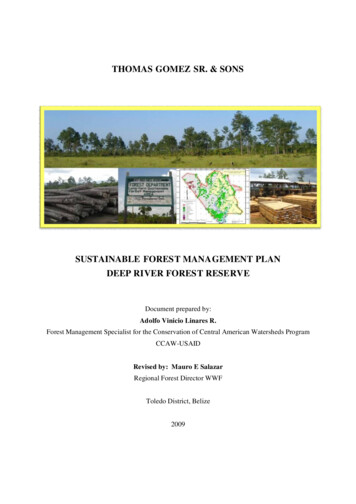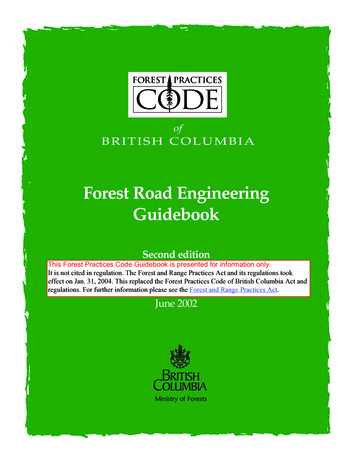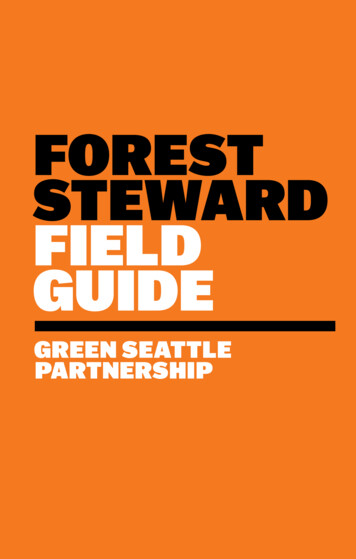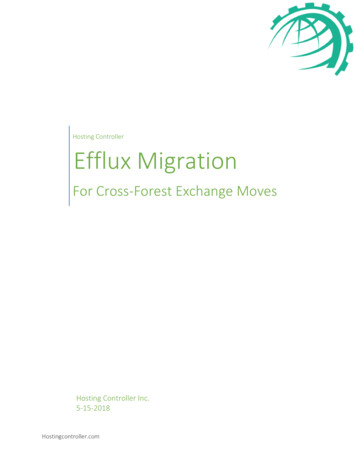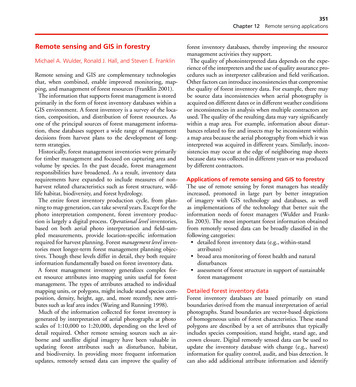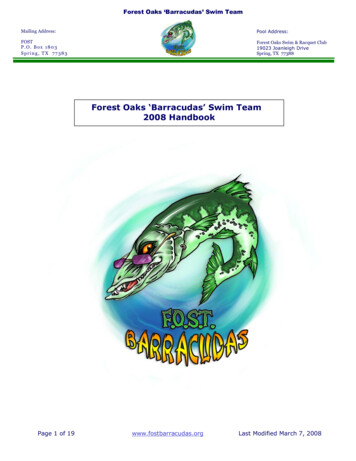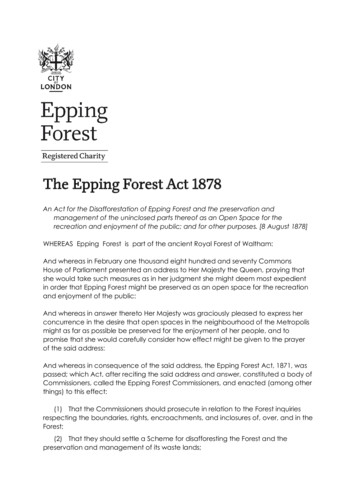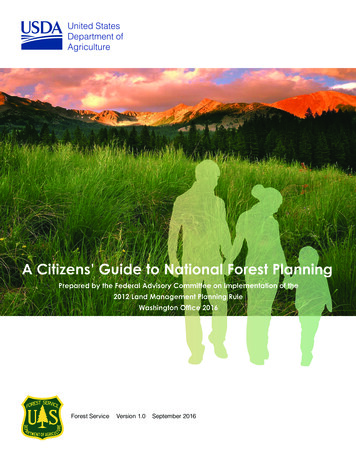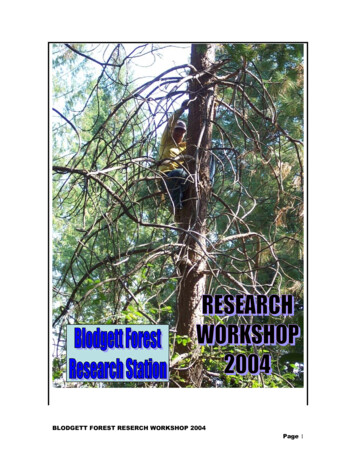
Transcription
BLODGETT FOREST RESERCH WORKSHOP 2004Page 1
University of California, BerkeleyCollege of Natural ResourcesCenter for ForestryThe Center for Forestry provides leadership in the development of basic scientificunderstanding of ecosystem process, human interactions and value systems, andmanagement and silvicultural practices that ensure the sustainability of forest land.The Center pulls together interdisciplinary teams of campus faculty, Cooperative Extensionspecialists and advisors, and staff from various agencies and organizations to developresearch projects, outreach and public education activities, and policy analysis on issuesaffecting California’s forest lands.The Center for Forestry manages five research forest properties: Baker Forest/U.C.Forestry Summer Camp, Blodgett Forest, Howard Forest, Russell Reservation, and WhitakerForest. These offer field locations and facilities (lodging, meeting rooms) for research andworkshops on forestry issues.145 Mulford Hall, #1634501 Blodgett Forest RoadBerkeley, CA 94720-3114Georgetown, CA 95634(510) 642-0095(530) 333-4475e-mail: forestry @nature.berkeley.edu - - - http: //nature.berkeley.edu/forestryBAKER FOREST/UC SUMMER CAMPDesigned as a summer instructional camp forUC Berkeley forestry students, situated inPlumas County. Camp facilities for up to 100persons are on 40 acres of USDA ForestService property by special use permit.Adjoining 80 acre Baker Forest is heavily usedas an outdoor laboratory.BLODGETT FORESTIn El Dorado County, the most developed of thefield sites, Blodgett’s primary use is for researchand practical demonstrations of forestrypractices. The forest is divided in managementcompartments, based on land use and study.Facilities include residences, rough labs,conference and shop space.RUSSELL RESERVATIONDonated to UC in 1961, this land was originallypart of a Spanish land grant in what is nowContra Costa County. Russell research includesextensive forest genetic and tree improvementresearch. An observatory is located on site, as isa seismology study. Some residences andmeeting facilities are available.HOWARD FORESTHoward Forest is 90 acres alongside Highway101 in Mendocino County. A major CaliforniaDepartment of Forestry and Fire Protectionfacility is located here, the only structures onsite. Prototype forest and agroforestmanagement plans for non-industrial forestlandowners have been developed here.WHITAKER FORESTWhitaker Forest is 320 acres of giant sequoiaand mixed conifer forest at Tulare County’supper reaches between Kings Canyon andSequoia National Park. Current research on thisimpressive site includes all-terrestrial vertebrateinventories and permanent vegetation andstream resource inventories.BLODGETT FOREST RESERCH WORKSHOP 2004Page 2
DONALD L. DAHLSTEN1933-2003A respected expert in biological control and forest entomology, and aleader in biological control research, Donald Lee Dahlsten passed awaySeptember 10, 2003, after a long illness. Dahlsten’s research focused ondevelopment of ecologically sensitive methods of controlling insects attackingtrees.Dahlsten received his bachelor’s in entomology from UC Davis, thentransferred to UC Berkeley for his graduate studies. After a brief teaching periodat Los Angeles State College, Don returned to the Berkeley campus, where heestablished himself as an contributing and influential member of the UC faculty.Don’s research led him to ground breaking contributions, most notably hiswork on psyllid pests that attack eucalyptus trees. He introduced a wasp speciesthat effectively saved blue gum eucalyptus trees in nurseries throughoutCalifornia. He was also well known for his research activities on tree-killing barkbeetles and factors that attracted theirnatural enemies. Dahlsten maintainedone of the largest databases ofinsectivorous birds in California andwas considered an expert on thebiology of the chestnut-backedchickadee.Don used Blodgett Forest as hisresearch site through nearly all of his40 year career. His Blodgett researchof the last few years, focused on Ipsparaconfusus responses to host treesand associated fungal factors, nest siteselection for mountain and chestnutbacked chickadees and pheromoneattraction of bark beetle predators. Hewas one of the primary investigators ofthe Fire and Fire Surrogate Studycurrently underway, looking at fire andtreatment effects on ground beetlesand spiders.Don’s contributions earned himthe UC Berkeley Distinguished ServiceAward and the College of Natural Resources Citation. He had also received theUC Berkeley College of Natural Resources Outstanding Teaching Award.BLODGETT FOREST RESERCH WORKSHOP 2004Page 3
ABSTRACTS2004 Blodgett Forest Research WorkshopTable of ContentsAMACHER, Andrew J., R. H. Barrett, and S. L. StephensThe Fire and Fire Surrogate Study: Effects of Fire and MechanicalTreatments on Avian Nest Survival.Pg. 1APIGIAN, Kyle and Donald L. DahlstenEffects of fire and fire surrogate treatments on leaf litter arthropods:Initial post-treatment.Pg. 2BARRETT, Reginald H. and Andrew J. AmacherThe Blodgett Fire and Fire Surrogate Study – Wildlife, Camera TrapResults.Pg. 3BÊCHE, L. A., S. L. Stephens, and V. H. ReshEffects of prescribed fire on channel morphology and instream largewoody debris at Blodgett Forest Research Station.Pg. 4BEHLING, ChetA Pro-Active Approach to Road Abandonment: Stream RestorationAfter Culvert Removal.Pg. 5BONIELLO, Ralph IV and Joe R. McBrideThe influence of spatial crown variation on scaled estimates of carbonand water flux in three Sierran conifers.Pg. 9DREWS, Erik S. and Bruce R. HartsoughBlodgett FFS site Productivity and Cost Analysis for MechanicalTreatment and Burning.Pg. 11BLODGETT FOREST RESERCH WORKSHOP 2004Page 1
FARMER, Delphine K., Paul J. Wooldridge, Ronald C. CohenFirst measurements of reactive nitrogen oxide fluxes over a ponderosapine plantation.Pg. 13GERSHENSON, ALEXANDER AND WEIXIN CHENGControls of Canopy Activities on Roots and Soil Carbon Dynamics in aYoung Ponderosa Pine Forest: Preliminary Root Observations.Pg. 14GERSONDE, Rolf and Kevin L. O’HaraDeveloping a hybrid growth model for multiaged Sierra Nevada mixedconifer forests.Pg. 15GOLDSTEIN, ALLEN H., MEGAN MCKAY, MEREDITH R. KURPIUS, GUNNAR W.SCHADE, ANITA LEE, AND RUPERT HOLZINGERForest thinning dramatically enhances ozone flux due to reactions withelevated emissions of biogenic hydrocarbons.Pg. 17HILLE, Marco and Scott StephensEffects of tree crowns on duff consumption.Pg. 19HILLE, Marco, Scott Stephens and Lars SchmidtRestoring forest composition and structure with prescribed fire.Pg. 21HIPKIN, ChristopherCertification Plans for Center Properties.Pg. 24HOLZINGER, Rupert, Anita Lee and Allen H. GoldsteinLarge vertical gradients indicate emission and photochemicallyproduction for a wide variety of organic trace gases in a PonderosaPine plantation in the Sierra Nevada Mountains of California.Pg. 25LEE, Anita, and Allen H. GoldsteinOzone Oxidation of Monoterpenes, Sesquiterpenes, and OxygenatedTerpenes: Product Yields and Relevance to Field Observations andAtmospheric Chemistry.Pg. 26BLODGETT FOREST RESERCH WORKSHOP 2004Page 2
LIBBY, W. J.Analyses by County, Special Trees and Borders: 14-Year Data. RussellReservation Kuser Redwood Trail.Pg. 28LUNDEN, Melissa M., Douglas R. Black and Nancy J. Brown; Anita Lee,Gunnar W. Schade, and Allen H. GoldsteinFine Particle Formation And Processing In A Sierra Nevada Forest.Pg. 30MISSON, Laurent, Megan McKay, and Allen GoldsteinEffect of climate variability and management practices on carbon,water and energy fluxes of a young ponderosa pine plantation at theBlodgett Forest Ameriflux Site.Pg. 31MOGHADDAS, Emily E.Y. and Scott L. StephensSoil responses to the Fire and Fire Surrogate Study.Pg. 33MURPHY, J. G., D. K. Farmer, D. A. Day, P. J. Wooldridge, R. C. CohenDistribution of Reactive Nitrogen at Two Sites in the Sierra Nevada.Pg. 34ROLLER, GaryBaker Forest Proposed Management Plan.Pg. 35SEAMANS, Mark, Michelle Crozier, and R.J. GutierrezEcology of the California Spotted Owl in the North-Central SierraNevada.Pg. 37STARK, Daniel T., Andrew J. Storer, David L. Wood, Scott L. StephensThe Effects of Fire and Fire Surrogate Treatments on Insects andPathogens in Sierran Mixed Conifer Forests.Pg. 39STARK, Daniel T., Andrew J. Storer, David L. Wood, Scott L. StephensBark beetle landing rates as indicators of future tree mortality.Pg. 40BLODGETT FOREST RESERCH WORKSHOP 2004Page 3
STEPHENS, Scott L and Jason J. MoghaddasFire Hazard and Silvicultural Systems: 25 Years of Experience from theSierra Nevada.Pg. 43STEPHENS, Scott L. and Jason J. MoghaddasVegetation Change and Fire Performance in Fire and Fire SurrogateTreatment Units.Pg. 45STORER, Andrew J., Daniel T. Stark, David L. Wood, and Scott StephensDevelopment of Entomology and Pathology Hypotheses of Long TermImpacts of Fire and Fire-Surrogate Treatments on Sierra Mixed ConiferForests.Pg. 46TANG, Jianwu, Dennis Baldocchi, Allen Goldstein, Liukang Xu, LaurentMissonPulse effects of soil respiration after rain events in California.Pg. 48TORN, Margaret S., Todd Dawson, Julia Gaudinski, Jeffrey Bird andStefania MambelliQuantifying the Importance of Belowground Plant Allocation forSequestration of Carbon In Temperate Forest Soils.Pg. 49TRUEX, Richard L. and William J. ZielinskiEffects Of Fire And Fire Surrogate Treatments On Fisher Habitat.Pg. 51WARING, Kristen M. and Kevin L. O’HaraStand structural response to decline of sugar pine in California’s mixedconifer forests.Pg. 52YORK, Jennifer, John J. Battles, Carrie Salazer and Frieder G. SchurrWebApps at the Center for Forestry: Year 2.Pg. 53BLODGETT FOREST RESERCH WORKSHOP 2004Page 4
YORK, Robert A., Robert C. Heald, John J. Battles, and Frieder G. SchurrEstablishment and recruitment of giant sequoia in experimental gaps.Pg. 55RESEARCH PROJECTS LISTSBLODGETT FOREST RESEARCH STATIONRUSSELL FOREST RESEARCH STATIONWHITAKER FOREST RESEARCH STATIONBLODGETT FOREST RESERCH WORKSHOP 2004Page 5
The Fire and Fire Surrogate Study: Effects ofFire and MechanicalTreatments on Avian Nest survival.ANDREW J. AMACHER, R.H. BARRETT, AND S.L. STEPHENSThe Fire and Fire SurrogateAllstandswereintensivelystudy (FFS)is a national program, fundedsearched for nests during the avianby the Joint Fire Sciences Program, tobreeding season. Over 770 active nestsquantify the ecological and economicwere located between 2001-2003. Forconsequences of prescribed fire andopen-cup nesting species the mostmechanical fuel-reduction treatments.common were: the Dark-eyed Junco (n Thirteen forest ecosystems have beenselected across the United States thatwere once frequented by fire.We are conducting research onwildlife at Blodgett Forest ResearchStation, near Georgetown, California.Twelve Sierran mixed-conifer stands(15-25 hectares each) with similar standstructure, composition and managementhistories were selected randomly from er nests were monitored. tion),prescribed fire only, mechanical only(bothCassin's Vireo (n 79). A total of 74Mayfield daily survival rate was used toset of available stands.Each110), American Robin (n 104), andmasticationmechanical/fireADDRESS OF LEAD AUTHOR:University of California, BerkeleyEnvironmental Science, Policy, & Management151 Hilgard HallBerkeley. CA 94720-3110aamacher@nature.berkeley.eduBLODGETT FOREST RESERCH WORKSHOP 2004Page 1
Effects of fire and fire surrogate treatmentson leaf litter arthropods: initial posttreatment resultsKYLE APIGIAN AND DONALD L. DAHLSTENLeaf litter arthropods are importantone of four treatments: prescribedcomponents of all forest ecosystems,burning, mechanical treatments (timberservingdetritivores,harvesting and mastication), mechanicalherbivores, as well as food for higherfollowed by burning treatments, ortrophic levels.control. Five traps were placed withingroundaspredators,Some groups, such asbeetles(Carabidae),spiderseach of5 randomly selected plots in(Araneae), and ants (Formicidae) haveeach of the 12 compartments. Insectsbeen studied extensively and have beenwere collected in propylene glycol overshown to have variable responses tothe course of five days each month, fromdisturbances such as fire and timberJune through September.harvesting. The abundance and diversityspecies list formed based on three yearsof these taxa make them valuable asof trapping shows very high diversity ofindicators of forest health. The effectsground active beetles ( 250 species inof fire and harvesting on these groups46 families) and ants (23 species) ire/FireoftheA completeWe will present the initialSurrogateresults of the effects of the FFSThree-treatments on these groups, as well ashundred pitfall traps were placed in 12discuss the ongoing and future analysisforest compartments that experiencedof these data.Study from 2001 to 2003.Department of Environmental Science, Policy, and ManagementUniversity of California, Berkeley201 Wellman Hall #3112Berkeley, CA, 94720BLODGETT FOREST RESERCH WORKSHOP 2004Page 2
The Blodgett Fire and Fire Surrogate StudyWildlife, Camera Trap ResultsREGINALD H. BARRETT AND ANDREW J. AMACHERwere analyzed using four metrics: totaldetections, latency to detection, meanfrequency of occurrence on stations, andfrequency of occurrence on plots.Results are presented as "responseindices" to facilitate comparisons amongspecies. No results were statisticallyThis work is a portion of the wildlifestudy associated with the Blodgettportion of the national Fire and FireSurrogates Study funded by the esignsignificant. We discuss the responsespredicted by the California WildlifeHabitatRelationshipsSystemandcompare them with our response indicesfor seven species of mammals.threetreatments and a control. Treatmentsinclude prescribed burning, mechanicalthinning and the two combined. Cameratraps were operated annually for ten daysat each of six stations within eachreplicate (plot, compartment). Peanutbutter and raw chicken baits wereprovided. Results by species detectedADDRESS OF LEAD AUTHOR:Department of Environmental Science, Policy, and ManagementUniversity of California, Berkeley151 Hilgard HallBerkeley, CA uBLODGETT FOREST RESERCH WORKSHOP 2004Page 3
Effects of prescribed fire on channelmorphology and instream large woodydebris at Blodgett Forest Research StationL.A. Beche, S.L. Stephens, and V.H. ReshPrescribed fire can be an efficient forestchange in LWD biomass, nor was theremanagement tool for fuel reduction andany significant difference in WD(p 0.05),asconcerns about the effects of fire oncompared to control reaches. Outside ofsensitive habitats, such as streams andthe intensively studied reach, LWD wasriparian areas, have often limited theirrecruited as a result of burned snagsuse in management.In late Octoberfalling into or over the stream channel.2002, an upland and riparian plotThis generally occurred in the most(approx. 50 acres) was prescribed burnedseverely burnt areas. There was a slightin the central Sierra Nevada, CA atincreaseBlodgett Forest Research Station. Onesediment in the study reach; however,year post-fire, we re-surveyed riparianfine sediment made up 90% of thevegetation, instream large woody debrissubstrate prior to the fire. These results,(LWD) and channel morphology (inone-year post-fire, indicate that althoughaddition to documenting changes inthe fire resulted in dramatic changes towateraquaticground cover in many areas, the effectmacroinvertebrates, algal biomass). Thison LWD and channel morphology wasstudy is employing a beyond-BACIminimal. In some cases (as with channelexperimental design, with one burned 1stmorphology), the documented effectsorder watershed (Dark Canyon Creek)cannot be attributed to the fire.quality,hydrology,andredistributionoffineand four unburned 1st order catchments.The fire itself was patchy, particularly inthe riparian areas, which resulted in amosaic of fire severity. In the primarystudy reach (200 m), there was no201 Wellman HallDepartment of Environmental Science,Policy and ManagementUniversity of California, BerkeleyCalifornia 94720-3112BLODGETT FOREST RESERCH WORKSHOP 2004Page 4
A Pro-Active Approach to RoadAbandonment: Stream Restoration AfterCulvert RemovalCHET BEHLINGIn an effort to protect watersheds,Streams develop a specific widthseveral road abandonment and streamand gradient in response to debris,restoration projects have been designedsediment and water produced in theand implemented at Blodgett Forestsurrounding watershed.Research Station.The Mutton Creekwidth is restricted by culverts, a series ofheadwaters stream restoration projectadjustments are made by the streamrepresents a pro-active approach to roaditself.abandonment.maintained, the risk of culvert failureundertakingA road abandonmentnearlyalwaysWhen streamIf culverts are not regularlyincludessignificantly increases. By restoring theremoval of culverts and the restorationnatural stream channel after culvertof any associated watercourses. Often,removal, in both orientation and slope,when forest roads are abandoned theytheare simply left to the mercy of physicaleffectively disconnect the old roadprocesses. This inaction often results insystem from the natural stream network.abandonmentprojectswilldetrimental outcomes. Since abandonedRoad abandonment includes sub-roads and culverts are not usuallysoiling road surfaces, planting an erosionmaintained, often sediment movementcontroloccursinletsplacement on erosion prone areas todevelop blockage from debris or beddivert water and potential soil movementrock, and soils may become saturated.and artificially planting native coniferThe latter is often the determining factorseedlings in abandoned aeas.in culvert failure. Improperly abandonedstream restoration techniques will beroads with failed drainage structuresdiscussed, including culvert and filloften become barriers to migration ofremoval, log placement in stream banks,aquatic life.the use of rip-rap and bio-degradablealongroadsurfaces,nativeAspen Mat.BLODGETT FOREST RESERCH WORKSHOP 2004mix,loggingslashSeveralAs a result of thesePage 5
lwithsignificantly lower erosion potential willbe created.ADDRESS OF LEAD AUTHOR:University of California, BerkeleyCenter for Forestry4501 Blodgett Forest RoadGeorgetown, CA :An undersized culvert on aspur road, scheduled to bepulled and abandoned.RIGHT:The spur road, no longer inuse, will be abandoned andbarricaded to vehiculartraffic.BLODGETT FOREST RESERCH WORKSHOP 2004Page 6
ABA: Debris removalafter a backhoe haspulled theabandoned culvert.CB: Gary Roller andJessica Range layingAspen-Mat. Themat will be securedto the stream bankwith biodegradablestakes to preventsoil movement.C: Chet Behlingdoing somehandwork inpreparation forgravel layering.DD: Weed-free strawis spread on newlyplanted areas toprevent erosion.BLODGETT FOREST RESERCH WORKSHOP 2004Page 7
ABOVE: Personnel from CDF/Tahoe and Center staff Gary Roller look at the completedabandonment project.BLODGETT FOREST RESERCH WORKSHOP 2004Page 8
THE INFLUENCE OF SPATIAL CROWN VARIATION ONSCALED ESTIMATES OF CARBON AND WATER FLUX INTHREE SIERRAN CONIFERS.RALPH BONIELLO, IV, AND JOE R. MCBRIDEIt is well accepted that physiologicalMorphological measurements of needlesand morphological variability exists withinfromthe crowns of trees. For example, sun leavescompartmentalize their crowns according toand shade leaves often differ in leaf area,statistically significant differences amongleaf mass, and photosynthetic capacity. Incategories of height, needle age, andaddition, nitrogen gradients have beenazimuth. Nitrogen analysis of these needlesmeasured in tree crowns that correlate wellwill allow us to identify more detailedwith light gradients.gradients within the crowns.These strategiespresumably exist to maximize the efficiencythesetreesallowedusPreliminary results of physiologicalof leaves with respect to carbon gain, andmeasurements will be presented.water and nutrient c responses to light and CO2generally accepted, physiological variabilityconcentration, for future input into thehas rarely been measured systematicallyMAESTRA model. MAESTRA is an openwithin tree crowns. In addition, it is notsource array model that scales leaf levelwellphotosynthetic parameters to the variouscrowncompartments contribute to the overalllevel.carbon and water fluxes of an individualmeasurements were taken approximatelytree.Quantification of the physiologicalonce a month. The curves developed fromvariability within tree crowns will allow forthese measurements provide an independentmore accurate scaling of leaf level responsesmeasure of needle transpiration and leafto whole tree or canopy performance.temperature, and allow for verification ofDuring the growing season of 2003,Diurnalmodel output.stomatalconductanceIn addition, leaf watervarious measures of leaf level physiologypotential measurements may be used towere made on an individual of each of aexamine whether differential water stressponderosa pine, Douglas-fir, and white fir.BLODGETT FOREST RESERCH WORKSHOP 2004Page 9
occurs within the crown, as well as itsinfluence on crown physiology.Ralph Boniello using an Li-1600 steady-state porometer to measure stomatalconductance. An Li-6400 gas exchange system, in the background, is measuring CO2and water exchange. Photo by Joe McBrideUniversity of California, BerkeleyDepartment of Environmental Science, Policy, and Management151 Hilgard HallBerkeley, CA 94720-3110BLODGETT FOREST RESERCH WORKSHOP 2004Page 10
Blodgett FFS Site Productivity And CostAnalysis For Mechanical Treatment andBurningERIK S. DREWS AND BRUCE R. HARTSOUGHThe Blodgett research forest hasworker/operator and for each machine. Aone of the test sites for the nationwideFire/Fire Surrogate (FFS) study. As part ofthis interdisciplinary study the cost andproductivity was evaluated for performingthree different treatments (replicated threetimes): mechanical thinning, mechanicalthinning combined with a controlled burn,and controlled burn. These three treatmentswere intended to leave the stands in thesame 80/80 condition, where a fire under the80th percentile conditions would leave 80percent of the stand living.For the productivity analysis of themechanicaltreatmentsinformationwascollected on the number of person-hoursworked, the number of machine-hours foreach machine, and the amount of materialremoved measured in tons.Using the productivity information aproduction rate was calculated for eachoperation step: felling, skidding, loading,and masticating. The production rate wasexpressed in terms of tons per hour, stemsof-average-size per hour, acres per hour. AcostperhourwascalculatedforBELOW: Masticator used for mechanicalthinning in the burn treatment compartments.Photo by Chris Hipkincost for each operation was calculated bymultiplying hours and cost-per-hour for eachperson and machine. The cost results wereexpressed in cost per ton, cost per stem-ofaverage-size, and cost per acre. A similaranalysis was performed for the burns bytracking person-hours and equipment-hours.Preliminary results for the mechanicaltreatments were presented at last year’ssymposium.BLODGETT FOREST RESERCH WORKSHOP 2004Page 11
The controlled burn productivityNo information was available onresults were expressed as person-hours permaterial removed by the burns so no resultsacre, and equipment-hours per acre for eachwere calculated on a per-ton-removed, ormachine. After determining a cost-per-hourper-stem-of-average-sizefor each worker and piece of equipment aThe results from the Blodgett FFS site weretotal-cost per hour and a total-cost per acrecompared with results from several otherwas calculated.FFS sites.ADDRESS OF LEAD AUTHOR:Biological and Agricultural Engineering Dept.University of California, DavisOne Shields Ave.Davis, CA 95616530-752-7890drews4of7@yahoo.comBLODGETT FOREST RESERCH WORKSHOP 2004removedbasis.ABOVE:The Licensed Timer Operator (LTO)moves logs in a landing, utilizing a rubbertired skidder.Photo by Sheryl RambeauPage 12
First measurements of reactive nitrogenoxide fluxes over a ponderosa pineplantationDELPHINE K. FARMER, PAUL J. WOOLDRIDGE, AND RONALD C. COHENThe reactive nitrogen oxidesin creating instrumentation that meets(NOy NO NO2 peroxy nitrates the criteria for eddy covariance fluxes.alkyl nitrates HNO3 ) play a keyThe thermal-dissociation laser inducedroleandfluorescence (TD-LIF) technique (Day etatmospheric chemistry. Deposition ofal. 2002) provides an accurate methodthese species, in particular nitric acidfor measurements of fluxes of HNO3,(HNO3), is a major loss process from theperoxy nitrates (ΣPNs), alkyl nitratesatmospheric NOy reservoir, but also(ΣANs), and NO2. We describe the firstpotentially provides a key nitrogenmeasurements of these fluxes taken insource to forest ecosystems. Despite the2003 above a ponderosa pine plantationimportanceat the University of California gen fluxes, few measurements haveForest Research Station tower site.been made due to the technical difficultyDepartment of Chemistry,University of California, BerkeleyBerkeley, CA TT FOREST RESERCH WORKSHOP 2004Page 13
Controls of Canopy Activities on Roots andSoil Carbon Dynamics in a Young PonderosaPine Forest: Preliminary Root ObservationsALEXANDER GERSHENSON AND WEIXIN CHENGGlobally, belowground inirhizotronusingobservationthemethod,betweenwhich will continue for the next year andatmospheric C and the soil C pools.a half. Preliminary data, using rootHowever, a gap in our understanding ofcounts, show that the main peak in rootbelowground carbon fluxes in forestproduction occurs between May15 andecosystems in general, and specificallyJuly 15, with the bulk of growththe role that roots play in belowground Chappeningdynamics, is one of the primary factorscoincides with the increase of dailylimitingtheminimum temperatures, which remainedcontribution of forests as global Cbelow 5 C until mid-May. Root deathprocessors. This project is part of awas observed primarily in the firstlarger effort which aims to investigatemonth after emergence, if at all. The netthe role of aboveground controls on rootnumber of roots was the highest duringturnover and soil carbon sequestration inthe period between June and July, aftera mid-elevation, young ponderosa pinewhichplantation with a shrub understorycontinuous decline. Overwintering of(Arctostaphylos sp. and Ceanothus sp.)fine roots appears to be minimal,ourmajorecosystemsbelowgroundability toassessinweJune.observedThisatimingslowbutThis poster represents the firstalthough a second year of observationlook at the belowground activity in anwill be necessary for confirmation.experimental plot at the Blodgett ForestFurther implications and connectionsAmeriflux site in the Sierra Nevadawith research that includes canopy fluxMountains of California, USA.measurements and soil respiration willconductedthefirstseasonWeofbe discussed.UC Santa CruzDept. of Environmental Studiesagersh@ucsc.eduBLODGETT FOREST RESERCH WORKSHOP 2004Page 14
Developing A Hybrid Growth Model ForMultiaged Sierra NevadaMixed-Conifer ForestsROLF F. GERSONDE AND KEVIN L. O’HARAA growth model was developed formodel parameters were simplified formultiaged mixed-conifer forests in theuse of the model with inventory data.Sierra Nevada of California. The modelThe model calculates light at any pointincorporatesprocess-orientedwithin the canopy and can estimate meancomponents that predict tree growth as aincident and absorbed light of larger treefunction of leaf area and absorbed light,crowns. Boundary line analysis showedas well as empirical information on sitethat the maximum amount of leaf area aquality. Leaf area prediction equationstree maintained depended upon the meanwere developed from sapwood area –light rec
Sequoia National Park. Current research on this impressive site includes all-terrestrial vertebrate inventories and permanent vegetation and stream resource inventories. University of California, Berkeley College of Natural Resources Center for Forestry The Center for Forestryy provides leadership in the development of basic scientific

